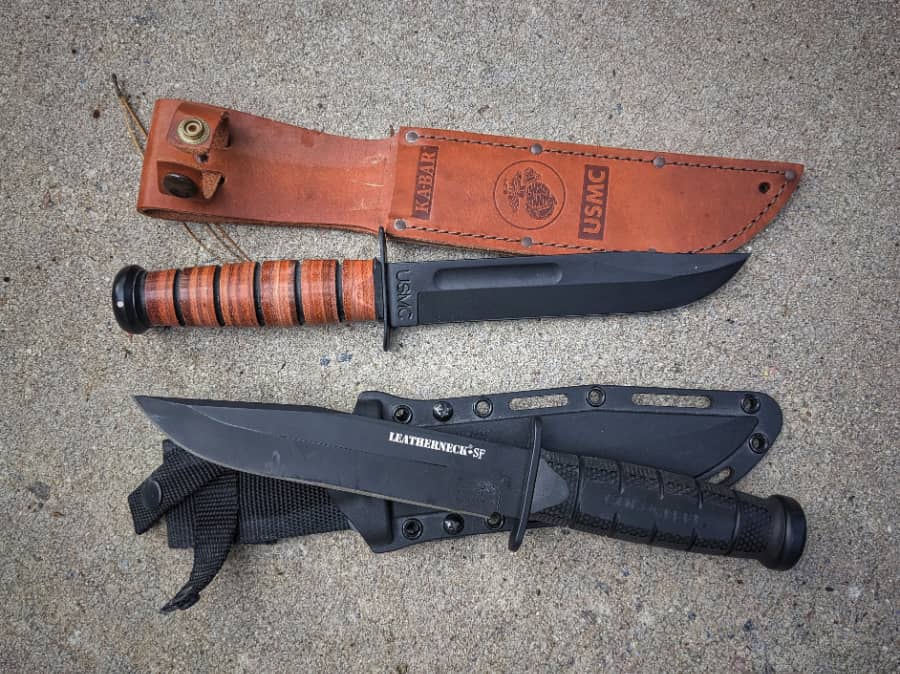The Legendary US Marine Ka-Bar Knife: 25 Lesser-Known Facts
Steeped in history and revered as a symbol of unwavering valor, the US Marine Ka-Bar knife has etched its indelible mark on both military lore and everyday culture. Beyond its well-known reputation, this iconic blade harbors a trove of lesser-known facts that shed light on its origin, design evolution, and enduring influence.
I am going to highlight 25 intriguing nuggets about the Ka-Bar knife, delving into its wartime prominence, design intricacies, and the lasting legacy it has forged. From its early days as a combat companion to its modern-day significance as a collector’s gem and survival tool, we unveil a blade’s hidden facets that have truly stood the test of time.
- Origin: The term “Ka-Bar” originates from the pronunciation of “Kill a Bear,” which was an early marketing slogan for the knife.
- Design Origins: The Ka-Bar knife’s design was inspired by the Bowie knife, with modifications to suit the Marine Corps’ needs.
- World War II: The Ka-Bar gained widespread fame during World War II and became a symbol of the U.S. Marines’ tenacity and toughness.
- Union Cutlery: The original manufacturer, Union Cutlery Company, later became Ka-Bar Knives Inc.
- US Navy Adoption: The Ka-Bar was initially designed for the U.S. Army, but it gained popularity when the U.S. Navy and Marines adopted it.
- Blade Steel: The knife’s blade is commonly made from 1095 carbon steel, which is known for its durability and edge retention.
- Tang: The full tang construction of the Ka-Bar knife enhances its strength and durability.
- Leather Handle: Early Ka-Bar knives featured leather washers in their handles, providing a comfortable grip.
- Utility Design: The knife’s clip-point blade design makes it versatile for various tasks, from combat to general utility.
- Combat Use: The Ka-Bar was used for both combat and utility purposes during World War II, such as cutting through obstacles and opening ammunition crates.
- Sheath Evolution: The Ka-Bar sheath has undergone design changes over the years, including variations in materials and securing mechanisms.
- Famous Owners: Celebrities like Clint Eastwood and Sylvester Stallone have been associated with the Ka-Bar knife.
- Influence on Other Designs: The Ka-Bar’s design has influenced other combat knife designs around the world.
- Survival Tool: Many outdoor enthusiasts and survivalists appreciate the Ka-Bar’s durability and versatility for wilderness scenarios.
- Cultural Icon: The Ka-Bar has become a cultural icon, often referenced in movies, video games, and literature.
- Handguard: The knife features a handguard to protect the user’s hand during combat and utility tasks.
- Variants: The original Ka-Bar design has spawned various versions, including those with serrated edges, different blade lengths, and modified handles.
- Collectibility: Vintage Ka-Bar knives, especially those from World War II, are highly sought after by collectors.
- Official Issue: The Ka-Bar was officially issued to U.S. Marines from World War II until the early 2000s.
- Modern Usage: While no longer standard issue, many Marines and military personnel still choose to carry a Ka-Bar as a personal knife.
- Camo Patterns: Some modern Ka-Bar knives feature camouflage patterns on their handles and sheaths.
- Production Changes: The manufacturing process of Ka-Bar knives has evolved over time, affecting factors like blade grind and finish.
- Knuckle Grip: Some Ka-Bar sheaths include a built-in knuckle grip, adding to their utility and self-defense capabilities.
- Marine Corps Emblem: Many Ka-Bar knives feature the U.S. Marine Corps emblem on their blade or handle.
- Customization: Ka-Bar knives are often customizable, allowing users to choose blade coatings, handle materials, and engraving options.
The US Marine Ka-Bar knife is a testament to the ingenuity, durability, and resilience that define its design and the warriors who wielded it. From its humble beginnings as a utilitarian tool to its transformation into an enduring symbol of courage, the Ka-Bar’s legacy remains an integral part of history.
As we reflect on these 25 lesser-known facts, we’re reminded that behind every blade lies a story, a purpose, and a connection to the past that continues to shape our present. So, whether it’s cherished by collectors, admired by enthusiasts, or wielded by those who value its dependability, the Ka-Bar knife remains an embodiment of the spirit that propels individuals to conquer challenges head-on.
With its rich history and remarkable versatility, the Ka-Bar knife remains an emblem of honor, resilience, and the unwavering commitment to excellence that defines the Marine Corps and those who share an appreciation for this legendary blade.

Alan Dale is an experienced backpacker and adventure sports athlete who pays the bills by writing. Married with a small brood, Alan often has his kids in tow on many of his adventures. You can visit Alan here: https://siralandale.com/

